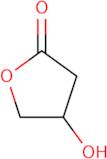Informations sur le produit
- 3,4-Dihydroxybutyric acid1,4-lactoneDihydro-4-hydroxy-2(3H)-furanonebeta-Hydroxybutyrolactone
- S-3-HYDROXY-γ-BUTYROLACTONE
- S-(-)-beta-Hydroxy-gamma-Butyrolactone
- (S)-3-Hydroxybutyrolactone
- (+/-)-beta-Hydroxy-gamma-butyrolactone
- 3-Hydroxy Gamma Butyrolactone
- 4-hydroxydihydrofuran-2(3H)-one
- (5S)-5-hydroxydihydrofuran-2(3H)-one
- (4S)-4-hydroxydihydrofuran-2(3H)-one
- (S)-(-)-3-Hydroxy-T-butyrolactone
- Voir d'autres synonymes
- 4-hydroxy-dihydrofuran-2(3H)-one
4-Hydroxydihydrofuran-2(3H)-one is a synthetic substrate that has been shown to be an antioxidative agent. It has been shown to have a number of properties including the ability to inhibit acid formation, the synthesis of microbial metabolites, and cell death. 4-Hydroxydihydrofuran-2(3H)-one can also serve as a precursor for the synthesis of fatty acids and mitochondria membrane potential. Its use in cell cultures has been shown to have an effect on recombinant cells, with decreased production of acid and increased mitochondrial membrane potential. 4-Hydroxydihydrofuran-2(3H)-one is synthesized by one biochemical pathway that begins with acetyl CoA and ends with dihydrofuran 2(3H)-ones. The enzyme involved in this reaction is called dehydrogenase. Deficiency in this enzyme leads to accumulation of 4-hydroxydihydrofuran





